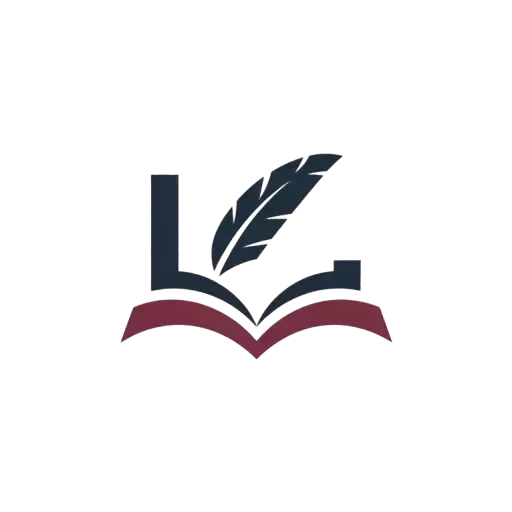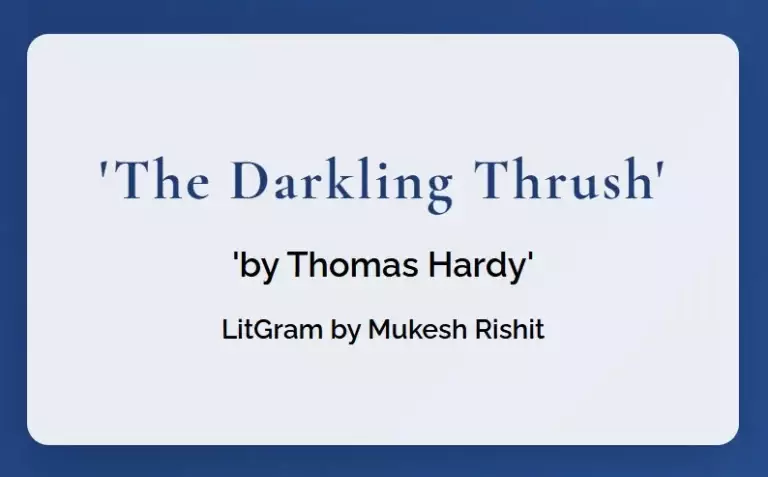Introduction to “The Darkling Thrush” by Thomas Hardy
Thomas Hardy’s “The Darkling Thrush” stands as a testament to the power of poetry to capture the human experience in all its complexity. Written on the cusp of the 20th century, this poem encapsulates the uncertainty and hope that accompanied the dawn of a new era. Hardy, known for his keen observations of nature and human behavior, crafts a masterpiece that resonates with readers across generations.
The poem’s setting is bleak and wintry, mirroring the poet’s somber mood as he reflects on the passing of time and the state of the world. Yet, amidst this desolation, an unexpected source of joy emerges, challenging the narrator’s pessimistic outlook. This juxtaposition of despair and hope forms the core of the poem’s enduring appeal.
As we delve into a line-by-line explanation of “The Darkling Thrush,” we will uncover the layers of meaning woven into Thomas Hardy’s verses. From the intricate imagery to the subtle use of language, each element contributes to a rich tapestry of emotions and ideas that continue to captivate readers more than a century after its publication.
Structure and Form of “The Darkling Thrush”
“The Darkling Thrush” follows a traditional poetic structure, consisting of four eight-line stanzas. This formal arrangement, known as octaves, provides a sense of order and symmetry that contrasts with the poem’s themes of chaos and uncertainty. The regularity of the form serves as a counterpoint to the tumultuous emotions expressed within the verses.
Hardy employs a consistent rhyme scheme throughout the poem: ABABCDCD. This pattern creates a musical quality that enhances the overall rhythm of the piece. The alternating rhymes contribute to the poem’s flow, guiding the reader through the narrative while maintaining a sense of anticipation for each new rhyme.
The meter of “The Darkling Thrush” is primarily iambic tetrameter, with each line containing four iambs (unstressed-stressed syllable pairs). This rhythmic structure mimics natural speech patterns, lending an air of conversational intimacy to the poem. Occasionally, Hardy deviates from this meter, using variations to emphasize certain words or ideas, adding depth to the poem’s auditory experience.
Stanza-by-Stanza Analysis of the Poem
Stanza 1: Setting the Scene
The opening stanza of “The Darkling Thrush” paints a vivid picture of a desolate winter landscape:
I leant upon a coppice gate
When Frost was spectre-grey,
And Winter's dregs made desolate
The weakening eye of day.
The tangled bine-stems scored the sky
Like strings of broken lyres,
And all mankind that haunted nigh
Had sought their household fires.
Thomas Hardy’s narrator positions himself at a “coppice gate,” a boundary between cultivated land and wild nature. This liminal space symbolizes the threshold between the old century and the new, between the known past and the uncertain future. The frost is described as “spectre-grey,” evoking images of ghosts and death, setting a somber tone for the poem.
The “weakening eye of day” personifies the sun, suggesting the fading of light and hope. The imagery of “tangled bine-stems” scoring the sky “like strings of broken lyres” creates a powerful visual metaphor. These bare vines resemble musical instruments that can no longer produce harmonious sounds, symbolizing the loss of beauty and artistry in the world.
Stanza 2: Deepening Gloom
The second stanza intensifies the atmosphere of despair:
The land's sharp features seemed to be
The Century's corpse outleant,
His crypt the cloudy canopy,
The wind his death-lament.
The ancient pulse of germ and birth
Was shrunken hard and dry,
And every spirit upon earth
Seemed fervourless as I.
Hardy personifies the landscape as the “Century’s corpse,” a powerful image that suggests the death of an era. The cloudy sky becomes a crypt, and the wind a mournful lament, further emphasizing the theme of endings and loss. The “ancient pulse of germ and birth” being “shrunken hard and dry” implies a halt in natural cycles of growth and renewal.
The final lines of this stanza reveal the narrator’s state of mind, projecting his own lack of fervor onto “every spirit upon earth.” This universalization of his personal feelings creates a sense of shared despondency, reflecting the collective mood at the turn of the century.
Stanza 3: The Thrush Appears
The third stanza marks a dramatic shift in tone with the unexpected appearance of the thrush:
At once a voice arose among
The bleak twigs overhead
In a full-hearted evensong
Of joy illimited;
An aged thrush, frail, gaunt, and small,
In blast-beruffled plume,
Had chosen thus to fling his soul
Upon the growing gloom.
The sudden emergence of the thrush’s song cuts through the gloom established in the previous stanzas. The bird’s “full-hearted evensong” contrasts sharply with the bleakness of its surroundings. Hardy’s description of the thrush as “aged, frail, gaunt, and small” with “blast-beruffled plume” emphasizes its vulnerability, making its joyful song even more remarkable.
The phrase “fling his soul” suggests a passionate, almost reckless abandon with which the thrush sings. This act of defiance against the “growing gloom” introduces a note of hope and resilience into the poem.
Stanza 4: Hope and Mystery
The final stanza explores the narrator’s reaction to the thrush’s song:
So little cause for carolings
Of such ecstatic sound
Was written on terrestrial things
Afar or nigh around,
That I could think there trembled through
His happy good-night air
Some blessed Hope, whereof he knew
And I was unaware.
The narrator struggles to reconcile the thrush’s joyful song with the bleak reality he observes. The phrase “So little cause for carolings” underscores the apparent disconnect between the bird’s ecstasy and the desolate surroundings. This leads the narrator to consider the possibility of a “blessed Hope” known to the thrush but hidden from human understanding.
The capitalization of “Hope” elevates it to a concept of great significance, perhaps even suggesting a divine or spiritual dimension. The poem concludes with a sense of mystery and the potential for optimism, leaving the reader to ponder the source and nature of this hope.
Symbolism and Imagery in “The Darkling Thrush”
Hardy’s poem is rich in symbolism and vivid imagery, each element carefully chosen to convey deeper meanings:
- The Coppice Gate: Symbolizes a threshold between different states or realms, representing the transition between centuries.
- Winter Landscape: Represents death, endings, and the bleakness of human existence.
- Broken Lyres: Symbolize the loss of art, beauty, and harmony in the world.
- The Century’s Corpse: Personifies the dying 19th century and the end of an era.
- The Thrush: Represents hope, resilience, and the enduring spirit of life in the face of adversity.
- The Thrush’s Song: Symbolizes joy, faith, and the possibility of renewal.
These symbols and images work together to create a complex tapestry of meanings, allowing readers to explore themes of time, nature, and the human condition.
Themes Explored in Hardy’s Masterpiece
“The Darkling Thrush” delves into several interconnected themes:
- The Passage of Time: The poem reflects on the end of the 19th century and the uncertainties of the future.
- Nature and Humanity: Hardy explores the relationship between humans and the natural world, finding both desolation and inspiration in nature.
- Hope and Despair: The contrast between the narrator’s gloomy outlook and the thrush’s joyful song encapsulates the tension between pessimism and optimism.
- Faith and Doubt: The thrush’s song suggests the possibility of faith or meaning beyond human understanding, while the narrator’s skepticism represents doubt.
- Resilience: The thrush’s ability to sing joyfully despite harsh conditions speaks to the resilience of the spirit.
- The Role of Art: The poem itself, like the thrush’s song, offers beauty and meaning in a seemingly bleak world.
These themes interweave throughout the poem, creating a rich tapestry of ideas that resonate with readers across different times and cultures.
The Significance of the Thrush in the Poem
The thrush serves as a pivotal figure in Hardy’s poem, embodying several important concepts:
- Symbol of Hope: Despite its frail appearance, the thrush’s powerful song represents an unexpected source of hope in a desolate landscape.
- Nature’s Resilience: The bird’s ability to sing joyfully in harsh conditions demonstrates the resilience of nature.
- Contrast to Human Pessimism: The thrush’s optimism stands in stark contrast to the narrator’s gloomy outlook, challenging human perceptions.
- Bearer of Hidden Knowledge: The poem suggests that the thrush possesses some knowledge or insight that eludes human understanding.
- Catalyst for Reflection: The thrush’s song prompts the narrator to reconsider his pessimistic views, opening the possibility for a shift in perspective.
By focusing on this small, seemingly insignificant bird, Hardy emphasizes the power of individual acts of joy and defiance in the face of overwhelming despair.
Hardy’s Use of Language and Poetic Devices
Thomas Hardy employs a range of poetic devices to enhance the impact of “The Darkling Thrush”:
- Alliteration: Examples include “frost was spectre-grey” and “blast-beruffled plume,” creating auditory interest and emphasis.
- Personification: The landscape is personified as the “Century’s corpse,” giving abstract concepts tangible form.
- Metaphor: The tangled vines are compared to “strings of broken lyres,” creating a powerful visual and conceptual link.
- Contrast: Hardy juxtaposes images of desolation with moments of joy, enhancing the poem’s emotional range.
- Assonance: The repetition of vowel sounds, as in “weakening eye,” contributes to the poem’s musicality.
- Enjambment: The use of run-on lines creates a sense of continuity and flow between ideas.
These devices work together to create a rich, multi-layered poem that engages the reader on both intellectual and emotional levels.
Interpreting the Poem’s Message and Meaning
“The Darkling Thrush” offers multiple layers of interpretation:
- Historical Context: The poem can be read as a reflection on the transition from the 19th to the 20th century, expressing both anxiety about the future and hope for renewal.
- Personal Reflection: It may represent Hardy’s own struggle with faith and doubt, using the natural world as a canvas for exploring these internal conflicts.
- Universal Human Experience: The poem speaks to the universal human experience of finding hope in unexpected places, even in times of despair.
- Ecological Message: Some interpret the poem as an early expression of environmental concern, highlighting the resilience of nature in the face of human-induced changes.
- Artistic Purpose: The poem itself, like the thrush’s song, can be seen as an act of creation that brings beauty and meaning to a seemingly bleak world.
These interpretations are not mutually exclusive; rather, they contribute to the poem’s enduring relevance and ability to speak to diverse audiences across time.
Conclusion: The Enduring Appeal of “The Darkling Thrush”
Thomas Hardy’s “The Darkling Thrush” continues to captivate readers more than a century after its publication. Its enduring appeal lies in its ability to address universal themes while remaining deeply rooted in a specific moment in time. The poem’s exploration of hope amidst despair, the cyclical nature of life and death, and the power of art to transcend bleakness resonates with readers across generations.
The vivid imagery, masterful use of language, and carefully constructed form all contribute to the poem’s lasting impact. Hardy’s ability to capture the complexities of human emotion and experience within the framework of a nature poem demonstrates the power of poetry to illuminate the human condition.


